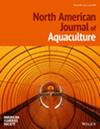大菱鲆(Lota Lota maculosa)幼虫早期断奶方案优化
IF 1.3
4区 农林科学
Q3 FISHERIES
引用次数: 0
摘要
摘要大菱鲆(Lota Lota maculosa)具有巨大的淡水商业养殖潜力。目前的幼虫饲养包括提供活体猎物进行初始摄食。进行了两项试验,以研究减少大腹虫幼虫的活猎物。在试验1中,对五种处理进行了评估:对照组(C)在孵化后11 - 50天(DPH)注射轮虫(臂轮虫)和蒿属(Artemia)。处理1 (Trt 1)使用11 ~ 78 DPH的活饲料,处理2 (Trt 2)只使用微颗粒饲料,处理3 (Trt 3)使用11 ~ 22 DPH的轮虫和21 ~ 50 DPH的Gemma微颗粒饲料,而处理4 (Trt 4)使用11 ~ 20 DPH的轮虫,然后在21 ~ 32 DPH时同时饲喂Artemia和EZ Artemia(液体Artemia替代品),然后在33 ~ 40 DPH时同时饲喂EZ Artemia。试验1显示,提供EZ青蒿可使活采食期缩短17 d,但与对照组相比,存活率和生长率显著降低。试验2共进行5种饲养处理,对照组(C)与试验1相同。处理1 (Trt 1)接受11 - 25 DPH的轮虫和20 - 50 DPH的EZ蒿;处理2 (Trt 2)有11‐30 DPH的Artemia菌株和25‐50 DPH的EZ Artemia菌株;治疗3 (Trt 3)只接受EZ青蒿素;第4组(Trt 4)在11 ~ 21 DPH时饲养Artemia,在22 ~ 32 DPH时饲养Artemia和Gemma,在33 ~ 78 DPH时只饲养Gemma。生存率从0%到30.94%不等,Trt 1、Trt 2和Trt 4使活采食期缩短了17 - 24天。Trt 1和Trt 2组的生存率与对照组无显著差异。总的来说,这些研究表明,在burbot幼虫养殖过程中消除轮虫或青蒿可以在对生存和生长的不利影响最小的情况下实现。本文章由计算机程序翻译,如有差异,请以英文原文为准。
Optimizing early weaning protocols for burbot (Lota lota maculosa) larvae
Abstract Burbot ( Lota lota maculosa ) hold enormous potential for freshwater commercial aquaculture. Current larval burbot rearing involves providing live prey for initial feeding. Two trials were conducted to investigate the reduction of live prey for larval burbot. In Trial 1, five treatments were evaluated: the control group (C) received rotifers ( Brachionus plicatilis ) and Artemia spp. from 11‐50 days post‐hatch (DPH). Treatment one (Trt 1) had live feeds from 11‐78 DPH, treatment two (Trt 2) received only microparticulate diets, treatment three (Trt 3) fed rotifers at 11‐22 DPH and Gemma microparticulate diets at 21‐50 DPH, while treatment four (Trt 4) had rotifers at 11‐20 DPH, then co‐feeding of Artemia spp. and EZ Artemia (liquid Artemia replacement) at 21‐32 DPH, followed by EZ Artemia at 33‐40 DPH. Trial 1 revealed that providing EZ Artemia reduced the live feeding period by 17 days, but survival and growth were significantly lower compared to the control. In Trial 2, five feeding treatments were assessed: the control group (C) was the same as in Trial 1. Treatment one (Trt 1) received rotifers at 11‐25 DPH and EZ Artemia at 20‐50 DPH; treatment two (Trt 2) had Artemia spp. from 11‐30 DPH and EZ Artemia at 25‐50 DPH; treatment three (Trt 3) received only EZ Artemia ; treatment four (Trt 4) had Artemia spp. at 11‐21 DPH followed by co‐feeding of Artemia spp. and Gemma Wean at 22‐32 DPH, and exclusive feeding of Gemma Wean from 33‐78 DPH. Survival rates ranged from 0% to 30.94%, with Trt 1, Trt 2, and Trt 4 reducing the live feeding period by 17‐24 days. Survival for Trt 1 and Trt 2 groups did not significantly differ from the control. Overall, these studies demonstrate that eliminating rotifers or Artemia during burbot larviculture can be achieved with minimal adverse effects on survival and growth.
求助全文
通过发布文献求助,成功后即可免费获取论文全文。
去求助
来源期刊
CiteScore
2.50
自引率
0.00%
发文量
46
审稿时长
18-36 weeks
期刊介绍:
The North American Journal of Aquaculture publishes papers on new research and practical experience in all areas of intensive and extensive fish culture. Topics include broodstock selection and spawning, nutrition and feeding, health and water quality, facilities and production technology, and the management of ponds, pens, and raceways.
The journal will consider papers dealing with ways to improve the husbandry of any aquatic species—marine or freshwater, vertebrate or invertebrate—raised for commercial, scientific, recreational, enhancement, or restoration purposes that may be of interest to practitioners in North America. Its scope includes both basic and applied science, but applied scientific endeavors—including practical experiences, descriptive studies, and other nontraditional, but pertinent works—are emphasized.

 求助内容:
求助内容: 应助结果提醒方式:
应助结果提醒方式:


